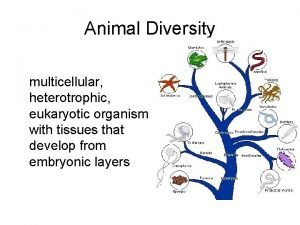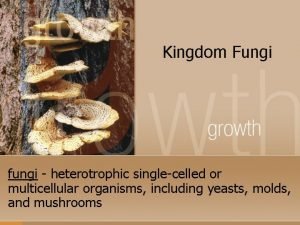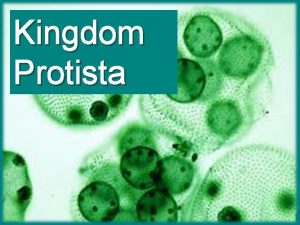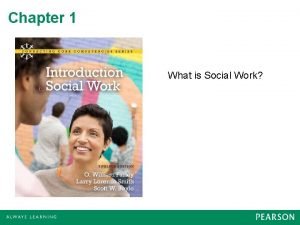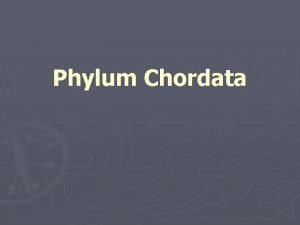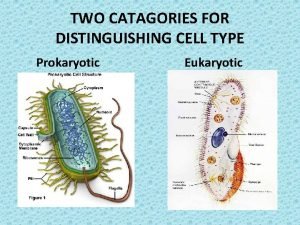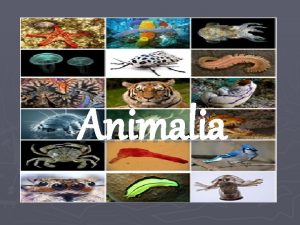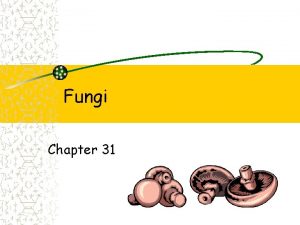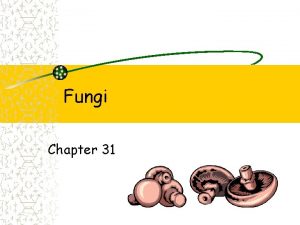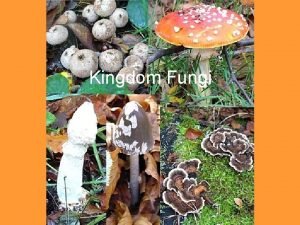Fungi Distinguishing Characteristics Entirely eukaryotic heterotrophic Some fungi







- Slides: 7

Fungi

Distinguishing Characteristics ► Entirely eukaryotic & heterotrophic ► Some fungi are unicellular ► Most are multi-cellular ► Multi-cellular representatives are twisted masses = mycelium, made up of chains of single cells called hyphae ► The mycelium of a fungus is actually hidden underground. ► Fungal cells have cell walls (made of chitin) just like plant cells, but they do not have chlorophyll & thus do NOT photosynthesize ► Many are decomposers but some are parasitic ► Classified based on their shape & how they reproduce ► Live in moist, shady areas

Method of Nutrition ► Completely heterotrophic ► But they do not engulf or catch their meals ► Fungi must live on or near their food supply ► Secrete digestive enzymes (chemicals) to breakdown their food source so that they can absorb the nutrients

Method of Reproduction ► Asexual ~ 1) breaking apart of hyphae 2) a few by budding or binary fission ► Sexual ~ sex cells combine to produce sexual spores that are spread by wind, water, or animals to a new area and then a new fungus can grow

The Good & the Bad §Major decomposers §Used in food making §Symbiotic relationships with plants – mycorrhiza, the plant gets proper root functioning while the fungus gets protection/nutrition §Parasitic §Disease & illness in humans Epidermophyton rubrum = “Ringworm” Tinea podias = “Athlete’s Foot”

Examples & Pictures Sac Fungi ~ largest group. Includes: yeasts, powdery mildews, truffles, morels. Threadlike Fungi ~ most of the individuals in this group are decomposers, some are parasites. Includes: black molds, dung fungi, Morchella esculenta & bread molds Rhizopus stolonifer Tuber magnatum

More Examples & Pictures Club Fungi ~ the umbrella shaped mushrooms. Includes: rusts, smuts, and puffballs Imperfect Fungi ~ all of these fungi reproduce asexually (usually via a host) because most are parasites. Exception – Penicillium & those used in food making Ustilago maydis Parasitic Examples: Tinea poidas = “athlete’s foot” & “ringworm” * Lichens ~ symbiotic relationship between a fungus & an algae. Important for the break down of rocks and minerals & thus the production of soil! Epidermophyton rubrum = “ ringworm” Staurothele clopima
 Heterotrophic eukaryotic organisms
Heterotrophic eukaryotic organisms Kingdom fungi multicellular or unicellular
Kingdom fungi multicellular or unicellular Are fungi heterotrophic or autotrophic
Are fungi heterotrophic or autotrophic Protista distinguishing characteristics
Protista distinguishing characteristics Similarities between sociology and social work
Similarities between sociology and social work Characteristics of phylum chordata
Characteristics of phylum chordata What are two distinguishing characteristics of prokaryotes
What are two distinguishing characteristics of prokaryotes Plants are multicellular
Plants are multicellular
